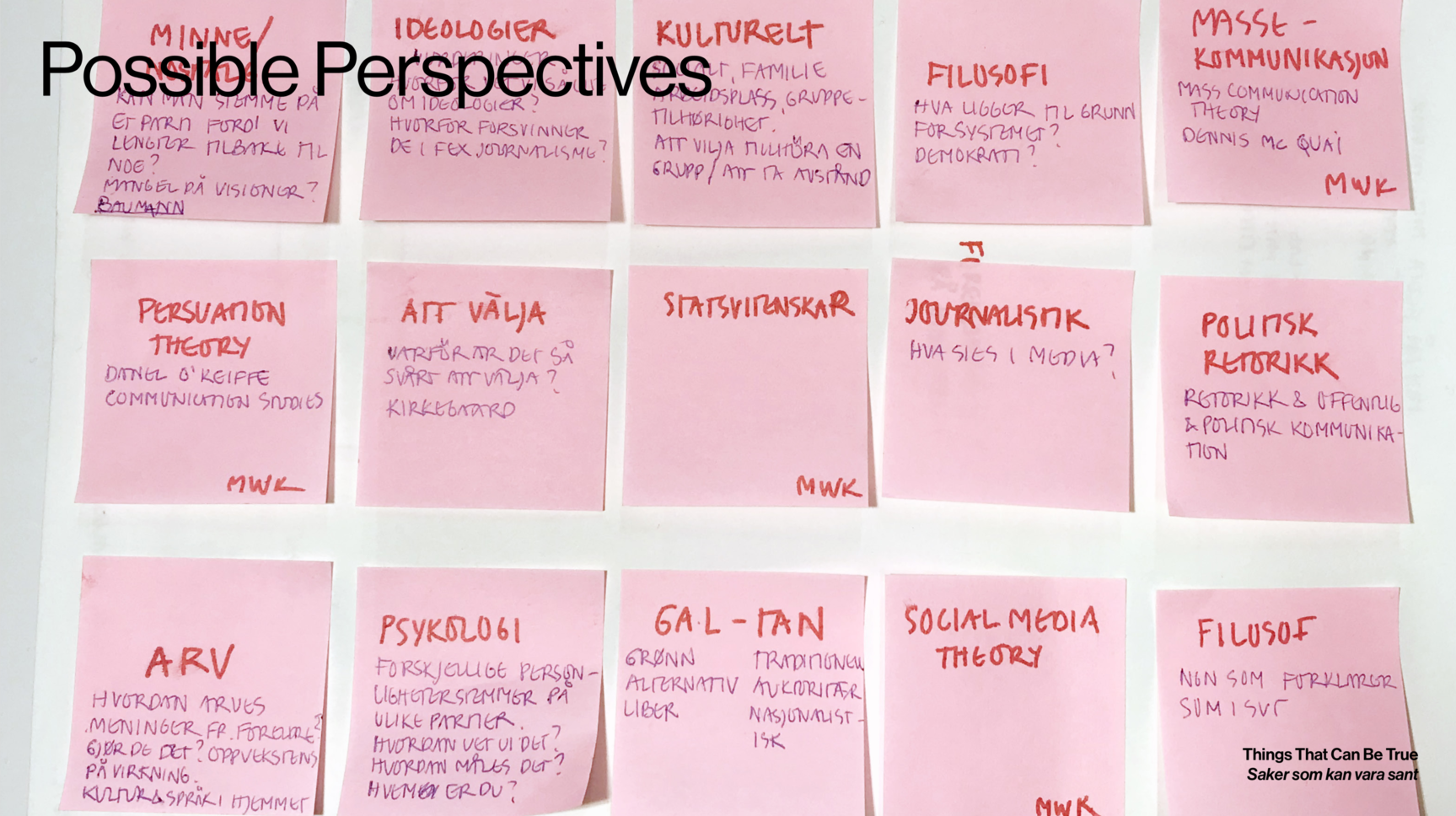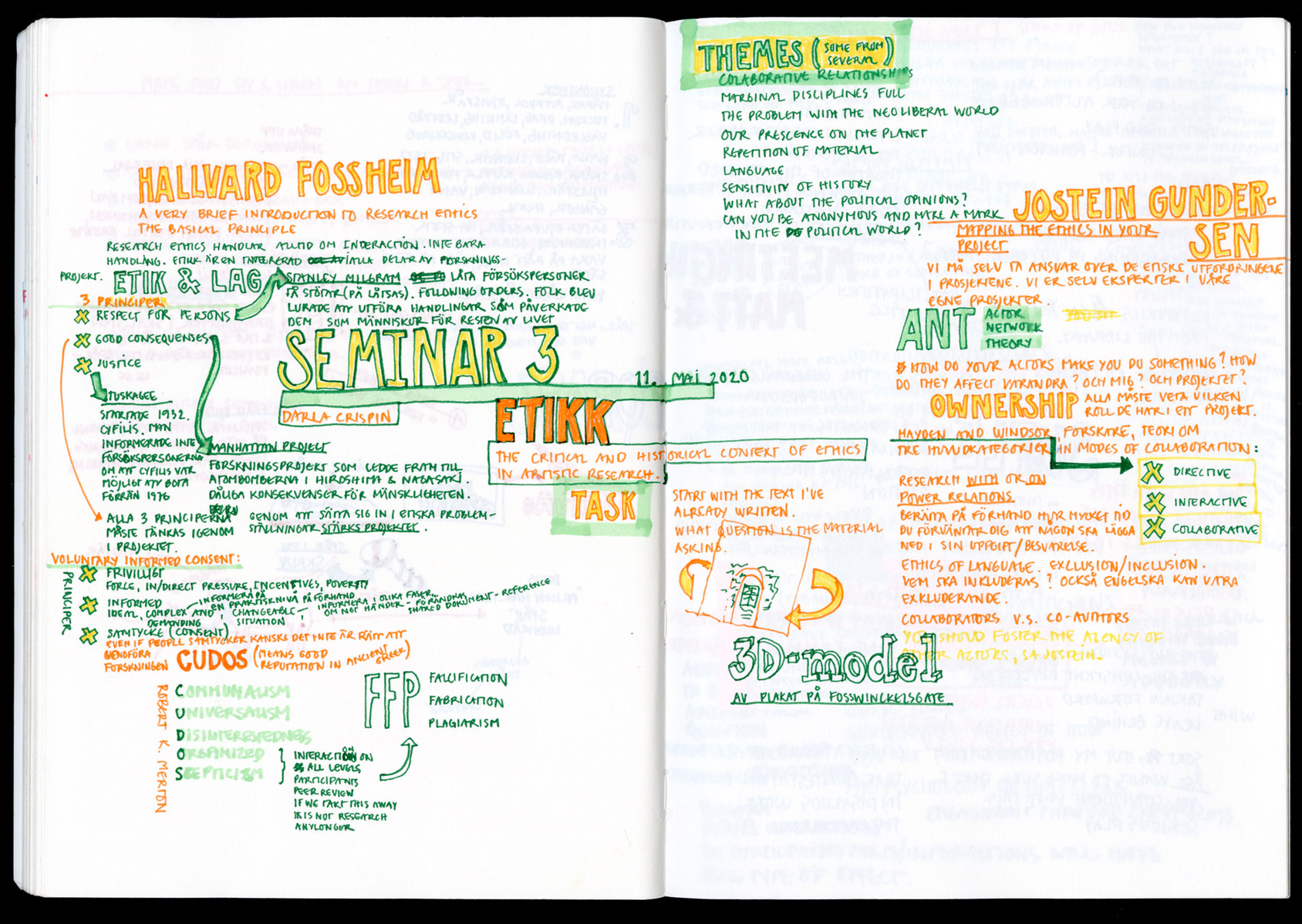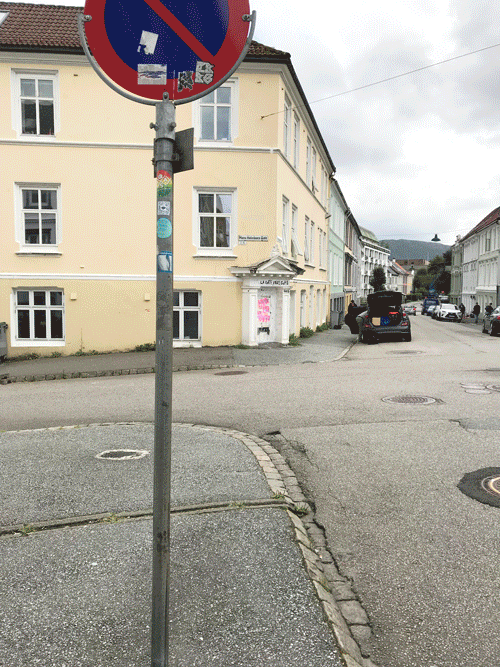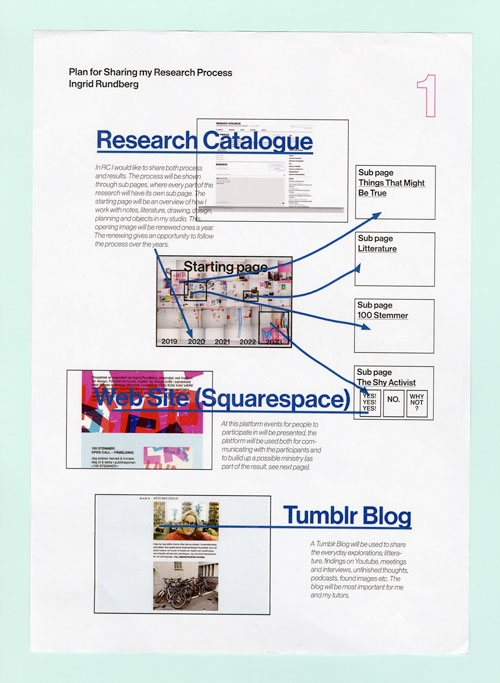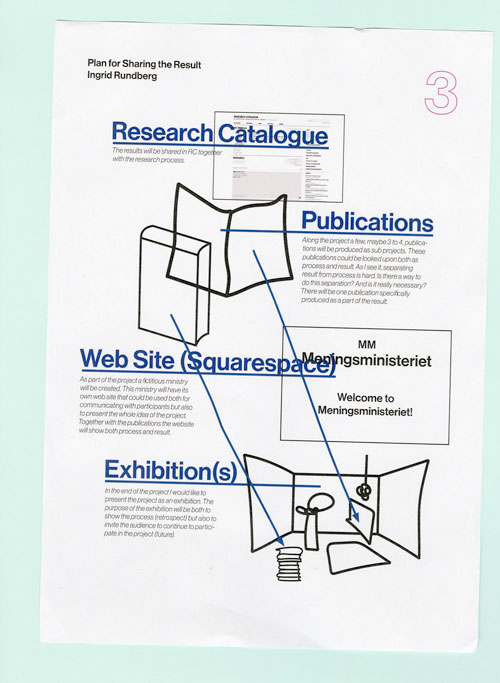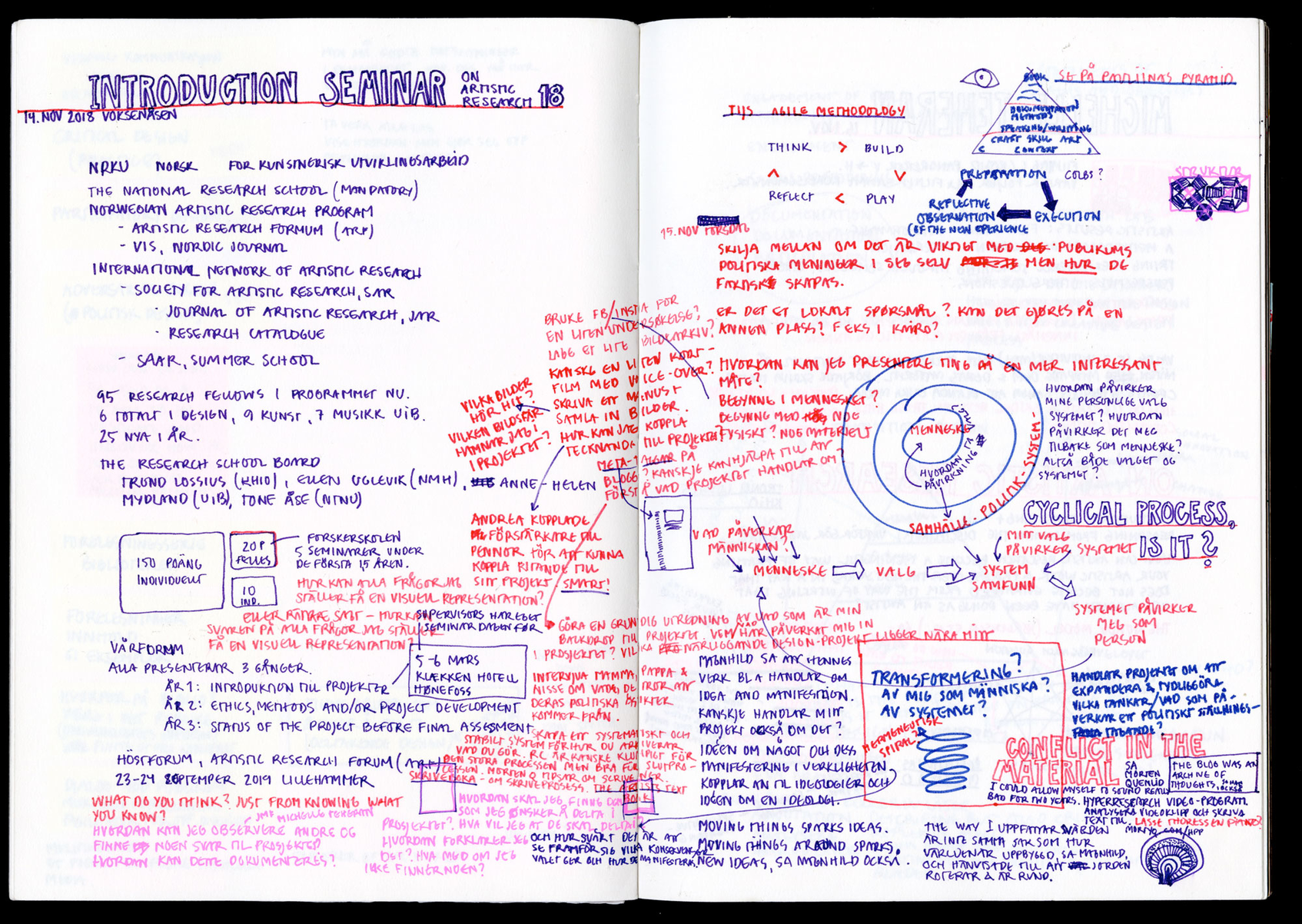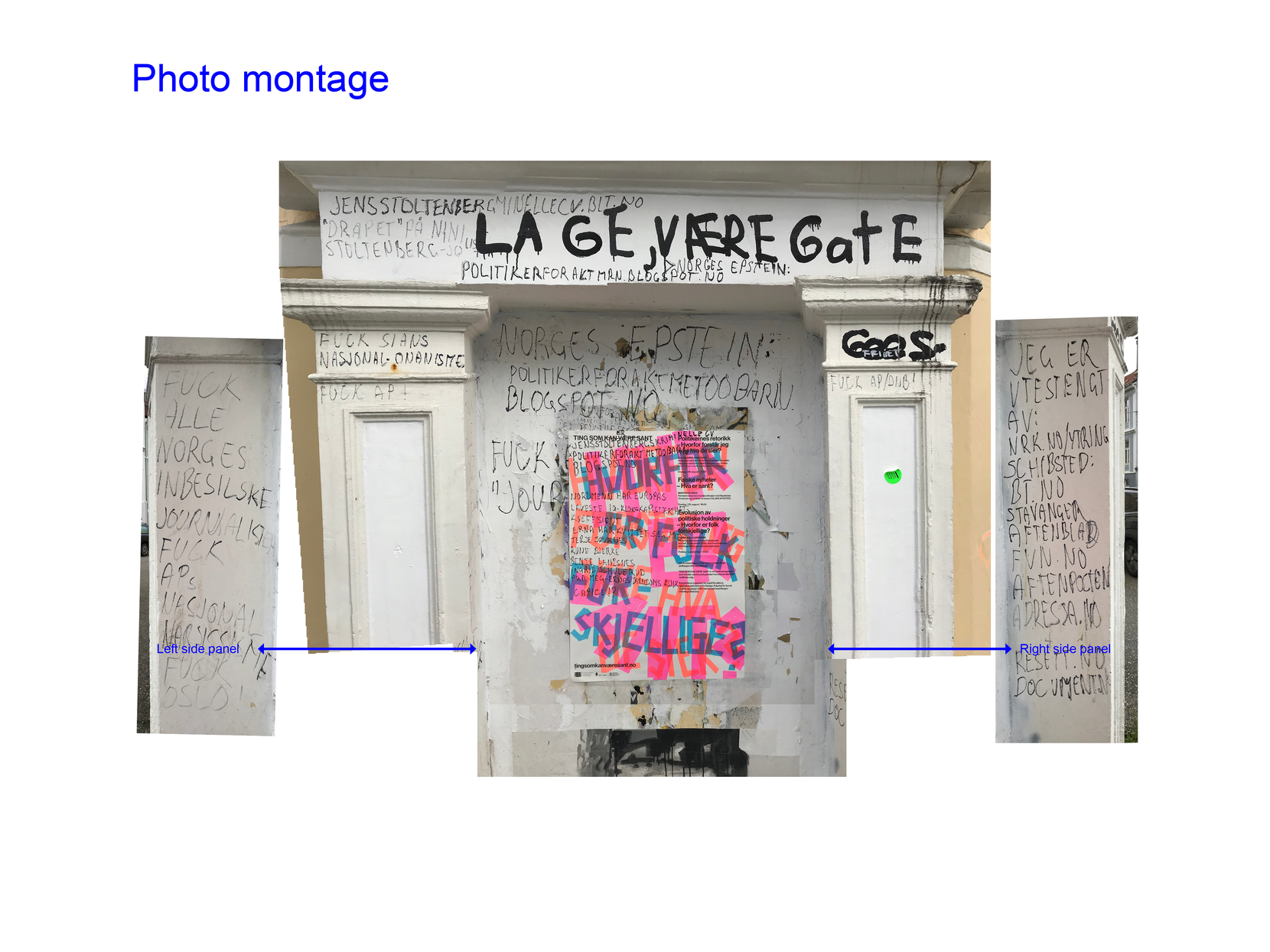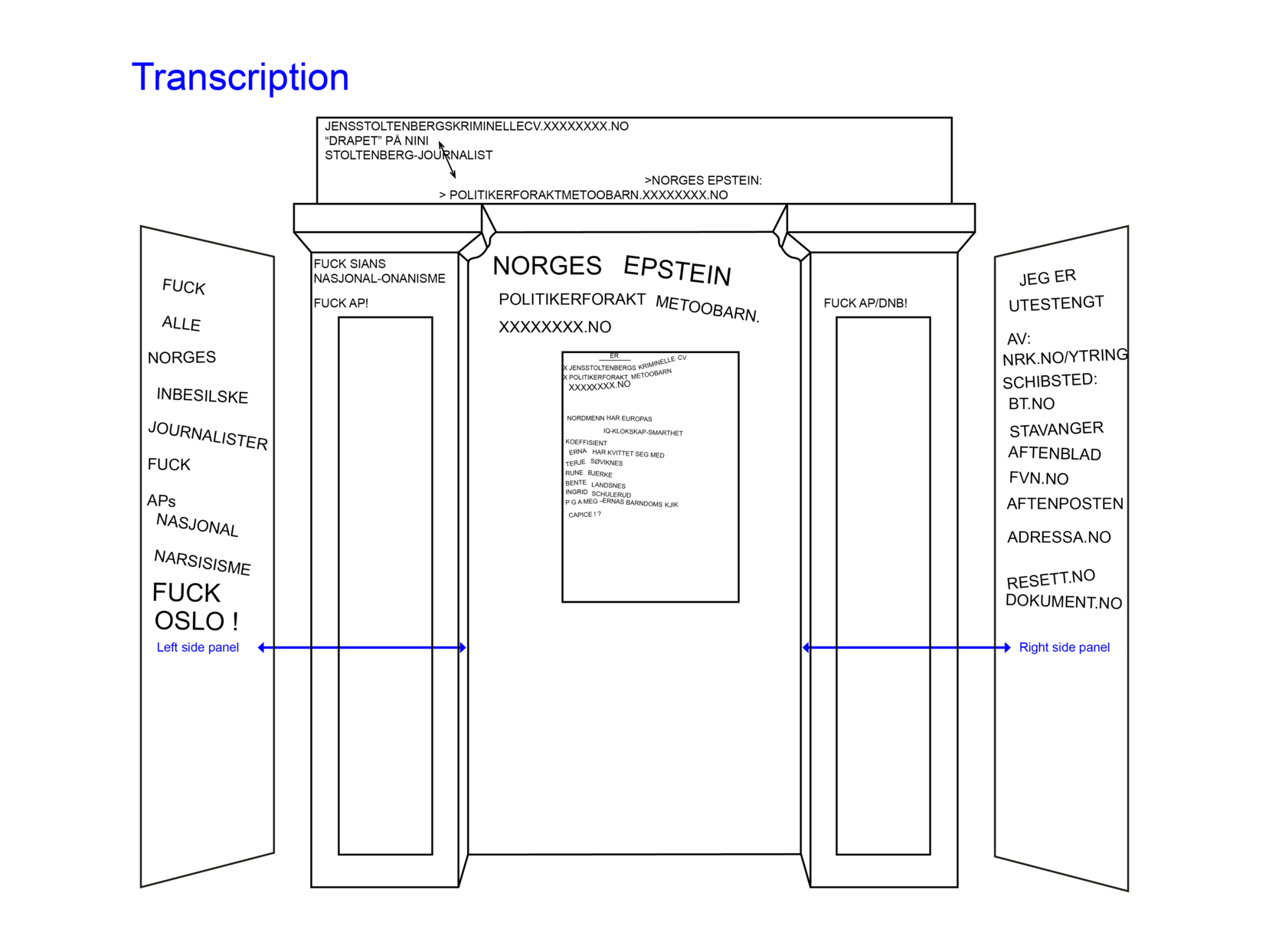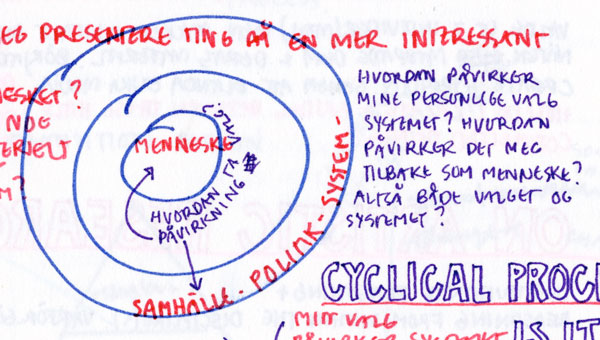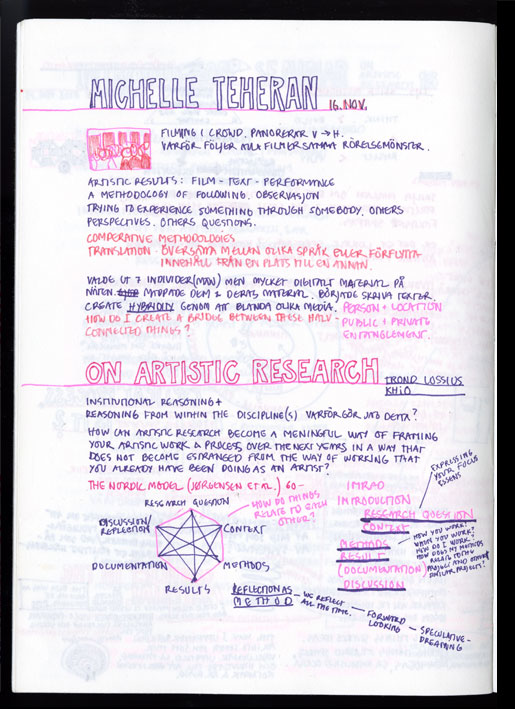TASK SEMINAR #1
Start-Up Seminar
Abstract to present your project
Present you project to research fellows, 20 minutes
TASK 1 SEMINAR #3
Ethics
Write a short text (max 250 words) in English. The text should include: your name, institution/department, starting year, project title, research field/project core, and what you consider as an ethical challenge in your project.
This project centers around the question of how your personal political opinions are being constructed, or maybe found. So far, I have been using several methods of investigation—creating a lecture series in the public, inviting the public to participate in printed matter and filming. In the near future and to deepen my investigative work, I will create the fictitious Ministry of Meaning (Meningsdepartementet in Norwegian), in which I can create public meetings, host reading groups and other research focused events and happenings.
The project is based in the discursive design field—design made as goods for thought.[1] With the core of the project within adversarial design, where design work is being done in a political sphere, that emphasizes the potentially positive aspects of certain (but not all) forms of political conflict.[2]
Having a participatory approach and mainly doing work in the public realm creates ethical challenges. Filming and recording in a public space are two, protecting the participants privacy is another. I am trying to keep a balance between unfolding the inner part of somebodies’ thoughts and communicating that personal material to an audience without making the participants uncomfortable or get the feeling of being exploited. As leader of this project I always have to be aware of the participants giving their time and contribution to the project and how the project can compensate and give credit back to all collaborators.
The theme—personal political opinions—can in itself invite to misbehavior. In an attempt to avoid this everybody that participate in the project has to use their real names—you cannot be anonymous.
I started the program in 2018, but is still in my first year due to maternity leave for seven months. My second year starts 1 June 2020.
[1] Tharp, Bruce M. & Tharp, Stephanie M., Discursive design: critical, speculative, and alternative things (Cambridge, Massachusetts: The MIT Press, 2018), 8.
[2] DiSalvo, Carl, Adversarial design (Cambridge, Mass.: MIT Press, 2012), 7.
ABSTRACT
THINGS THAT MIGHT BE TRUE
We live in a democratic state where we every second year have to decide what party to vote for. This can be more or less problematic and can also be filled with more or less anxiety. The democracy can, in some perspectives, seem demanding. The aim of this project is to through design research how the individual establishes and uncovers her personal political opinions.
The project is placed within the realms of critical design and participatory design. Critical design can be seen as a way of treating design and the design process in a way to create discussion around the contemporary society, everyday life and to question preconceptions and habitual routines. Participatory design is more of an active and ongoing collaboration between the designer, the project and the audience. To work with participatory design is of great importance in this project, as the dialogue between participants, the research material and the project is fundamental for maintaining a forward motion. The goal is to create a project where experiences and thoughts from the participants will not just be exhibited for the public, but also processed and cultivated together with the participants to create a new forum for discussion and reflection on the theme.
The result can consist of a wide range of media, for example photography, sound, object, moving image, collections and guidance – a multimodal event where several stories can be presented and run parallel. The project is not connected specifically to physical or digital components, but can include both.
In the initial research phase a lecture series will be organized at the Bergen Public Library. In this lecture series several perspectives on the topic of how the individual create her personal political opinions will be presented for the public. These different perspectives can for example be philosophical, psychological, ideological or connected to nostalgia, heritage or personality. One important aspect of the collaboration with the library is to relocate the research from only taking place in a secluded office space and instead let it continue out in the public sphere.
This project aims at continuing the development of design from being something that solves problems and mediates the thoughts and intentions of others (customer – client relationship) to design being a way of doing research, looking closely and thoroughly, investigate, linger and to unfold the theme of the project – earlier being mainly connected to journalism, political science and philosophy.
TASK 2 SEMINAR #3
Ethics
(How) can the question ‘be’ in the work?
We now ask that you should develop and fashion a small project, related to you own work and to the ethical issue that you have highlighted, therefore trying to address a particular ethical question through your own practice. This could take any number of forms - a brief video, a few lines of poetry or phrases of music, a short video performance, a photograph of a piece of work - but it will also be important for you to provide a brief explanatory text, so that the relationship of the nature of the ethical question to the artmaking that addresses it may be made clear to those outside your work.
TASK SEMINAR #2
Sharing & Documentation
Plan for sharing your artistic research process
Plan for documenting your artistic research process
Click on the image to reach the PDF-presentation
Ting som kan være sant // Things That ARE True
In August 2019 I organized a series of lectures in Bergen’s public library. I invited experts from different professions linked to the theme of my research on political choices, this project was done both to present several perspectives on what influences how we vote, and why, but also to begin the process of building an audience and find potential participants and collaborators in the project. I designed a poster that was distributed all over Bergen to inform the public about this lecture series.
So far, there are six actors; me, the three invited experts, Bergen Public Library (an institution), and the audience (about 45 people on three different occasions) who were expected to attend the different lectures.
While documenting my process with the posters, I notice that one of them is filled with scribbles (see GIF). And not only my poster, but also the walls behind it is covered in writing. Triggered by the poster another actor, the scribbler, appears – something that was totally unexpected, as people usually does not interact with graphic objects in this way.
On top of the poster (see Photo Montage) someone has used a marker with a rather forced and rigorous handwriting he (yes, I am pretty sure it is a man) clearly expresses his exclusion.
The scribbler writes that (see Transcription, right side panel) he is locked out from a number of the national newspapers' commentary fields as well as NRK, but also from dodgier websites such as dokument.no and resett.no. He also describes Jens Stoltenberg, the former Prime Minister of Norway and current Secretary General of NATO as Norway's Epstein – referring to the sexual predator Jeffrey Epstein who died in his jail cell at Metropolitan Correctional Center in 2019. The scribbler also changed the title of the lecture series on the poster from «Things That Can Be True» to «Things That ARE True».
It took me about thirty minutes to find this person online. So, should I contact him and invite him to participate in my project or not?
But, I do not want to or dare to include him.
I react instinctively and get scared.
This dilemma raises some ethical questions.
Not including him will reveal something that might seem like an underlying attitude in me, to only gather people that would like to participate in an open conversation in order to figure things out together, people that are used to a public discussion and knows its rules – in other words, people just like myself and with more or less similar agendas. On the other hand, including him might open up doors that could make my work richer by gathering participants from a wider spectrum of cultural groups, but at the same time so much harder to conduct. It could lead the project onto anti-democratic roads, and that is not the purpose of this project. As the project leader I need to protect both the participants and the project, but whom am I trying to protect here? Myself, the experts, the audience, the project as a whole, or the sixth actor – the Scribbler?
